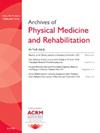基于神经接口的运动神经假体在中风后上肢神经康复中的应用:患者个体数据荟萃分析。
IF 3.7
2区 医学
Q1 REHABILITATION
Archives of physical medicine and rehabilitation
Pub Date : 2024-12-01
DOI:10.1016/j.apmr.2024.04.001
引用次数: 0
摘要
目的通过常规和个体患者数据(IPD)荟萃分析,确定基于神经接口的神经康复包括脑机接口的疗效,并评估与基于神经接口的神经康复积极反应相关的临床参数。对截至2022年2月的pubmed、EMBASE和Cochrane Library数据库进行了综述。研究选择使用神经接口控制的物理效应器(功能性电刺激和/或动力外骨骼)和报告的Fugl-Meyer评估-上肢(FMA-UE)评分的研究被确定。该荟萃分析在PROSPERO上前瞻性注册(#CRD42022312428)。遵循PRISMA准则。将FMA-UE评分的变化汇总以估计平均效应大小。临床参数和神经接口参数与研究水平变量和IPD进行亚组分析。数据综合纳入46项研究,共617例患者。涉及214例患者的29项研究报告了IPD。FMA-UE评分平均增加5.23分(95%可信区间[CI]: 3.85-6.61)。使用运动尝试的系统比运动想象产生更大的FMA-UE增益,持续4周对≤4周的训练也是如此。在IPD分析中,最小临床重要差异(MCID)以上的平均改善时间为12周(95% CI: 7至未达到)。6个月时,58%的患者改善至MCID以上(95% CI: 41%-70%)。单变量log-rank检验显示,严重损害患者(P= 0.042)和年龄50岁(P= 0.0022)与MCID以上改善失败相关。然而,在多变量Cox分析中,这些因素仅具有临界显著性(风险比[HR] 0.15, P=。08和HR 0.47, P=。06年,分别)。结论基于神经接口的运动康复可显著减少脑卒中后损伤,但效果不明显,应考虑在脑卒中神经康复中推广应用。本文章由计算机程序翻译,如有差异,请以英文原文为准。
Neural Interface-Based Motor Neuroprosthesis in Poststroke Upper Limb Neurorehabilitation: An Individual Patient Data Meta-analysis
Objective
To determine the efficacy of neural interface–based neurorehabilitation, including brain-computer interface, through conventional and individual patient data (IPD) meta-analysis and to assess clinical parameters associated with positive response to neural interface–based neurorehabilitation.
Data Sources
PubMed, EMBASE, and Cochrane Library databases up to February 2022 were reviewed.
Study Selection
Studies using neural interface–controlled physical effectors (functional electrical stimulation and/or powered exoskeletons) and reported Fugl-Meyer Assessment–upper-extremity (FMA-UE) scores were identified. This meta-analysis was prospectively registered on PROSPERO (#CRD42022312428). PRISMA guidelines were followed.
Data Extraction
Changes in FMA-UE scores were pooled to estimate the mean effect size. Subgroup analyses were performed on clinical parameters and neural interface parameters with both study-level variables and IPD.
Data Synthesis
Forty-six studies containing 617 patients were included. Twenty-nine studies involving 214 patients reported IPD. FMA-UE scores increased by a mean of 5.23 (95% confidence interval [CI]: 3.85-6.61). Systems that used motor attempt resulted in greater FMA-UE gain than motor imagery, as did training lasting >4 vs ≤4 weeks. On IPD analysis, the mean time-to-improvement above minimal clinically important difference (MCID) was 12 weeks (95% CI: 7 to not reached). At 6 months, 58% improved above MCID (95% CI: 41%-70%). Patients with severe impairment (P=.042) and age >50 years (P=.0022) correlated with the failure to improve above the MCID on univariate log-rank tests. However, these factors were only borderline significant on multivariate Cox analysis (hazard ratio [HR] 0.15, P=.08 and HR 0.47, P=.06, respectively).
Conclusion
Neural interface–based motor rehabilitation resulted in significant, although modest, reductions in poststroke impairment and should be considered for wider applications in stroke neurorehabilitation.
求助全文
通过发布文献求助,成功后即可免费获取论文全文。
去求助
来源期刊
CiteScore
6.20
自引率
4.70%
发文量
495
审稿时长
38 days
期刊介绍:
The Archives of Physical Medicine and Rehabilitation publishes original, peer-reviewed research and clinical reports on important trends and developments in physical medicine and rehabilitation and related fields. This international journal brings researchers and clinicians authoritative information on the therapeutic utilization of physical, behavioral and pharmaceutical agents in providing comprehensive care for individuals with chronic illness and disabilities.
Archives began publication in 1920, publishes monthly, and is the official journal of the American Congress of Rehabilitation Medicine. Its papers are cited more often than any other rehabilitation journal.

 求助内容:
求助内容: 应助结果提醒方式:
应助结果提醒方式:


